Cable choice is fundamental to an orderly and efficient network setup. Low-profile Ethernet cables are changing the way we think about connectivity by providing high performance and reliability without taking up too much space. Whether your concern is a cramped home office, constructing a professional office, or overseeing a data center, these ultra-thin cables offer a flexible solution for streamlined networking. This article analyzes why low-profile Ethernet cables stand out as the best option, pointing out their main advantages while offering suggestions for optimizing network setups. Discover with us how this design can improve not only the aesthetics but also the efficiency of your connectivity framework.
What is a Low Profile Ethernet Cable and Why Choose It?
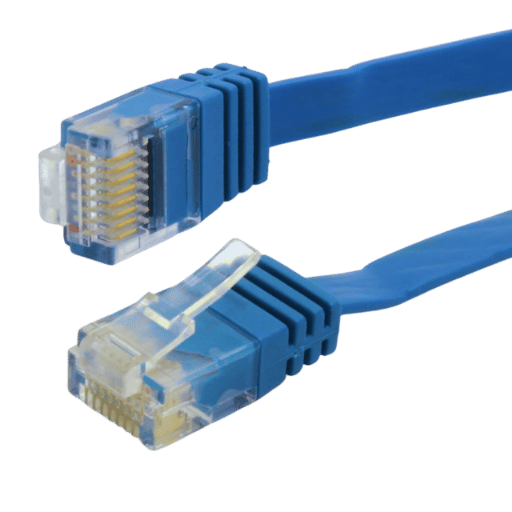
A low-profile Ethernet cable is a subtype of Ethernet cable with a thinner and more flexible profile that is easier to maneuver than standard Ethernet cables. The slim design enables effortless installation in confined spaces, including behind furniture, within walls, or in busy cable conduits. This makes the cable appropriate for environments where spatial efficiency is regarded as critical. Despite their low profile, these cables are capable of maintaining reliable performance while supporting high-speed data transmission and stable network connections. The use of low-profile Ethernet cables enhances the management of cables and clutter as well as the flow of air, especially in professional or technical environments in which systems and workstation organization and efficiency are essential.
Advantages of Low Profile Ethernet Cables
Space Efficiency
- Ethernet cables with a low profile have been created to have a low spatial footprint which makes them ideal for server racks, data centers or for any behind-wall installation.
Improved Airflow
- The use of low profile Ethernet cables helps increase airflow in enclosures or around devices as it helps eliminate clutter and do away with the need for extraneous cables, thus helping maintain optimal operating temperature for network equipment and improving system stability.
High-Speed Data Transmission
- Many low profile Ethernet cables nowadays offer Cat6, Cat6a and even Cat7 compatibility making the transmission of data telescopic due to the bandwidth capabilities of 10 Gbps and beyond, which can be delivered despite their smaller size.
Enhanced Flexibility
- Because of the compact and streamlined design of these low profile Ethernet cables, they can be easier to install in areas that require tight bending, sharper angles, or complex routing compared to standard Ethernet cables.
Durability and Reliability
- Low profile Ethernet cables are often made with high-grade materials which guarantee enhanced durability and reliable performance in challenging environments due to having advanced shielding techniques that reduce signal interference such as crosstalk and EMI.
Aesthetic Cable Management
- The slim profile of these cables also aids in organizing professional spaces such as office workstations, conference rooms and home theaters due to creating a more neat appearance.
Cost Effective
- In the context of modern networking and organizational requirements, low profile Ethernet cables are often low-cost and professionally advanced at the same time, representing value for quality and performance.
Integrability
- These as well are low and widely compatible with standard networking peripherals such as routers, switches, patch panels, and computers ensuring smooth operation within an organization.
How Does a Thin Network Cable Improve Performance?
Using thin network cables offers the advantage of enhanced performance because signal degradation and data loss over short and moderate distances are much easier to control. Their small size allows for better organization of cables which helps reduce the clutter as well as the interference in the network which improves its overall stability. Furthermore, their compact size increases ventilation in server and other confined areas which reduces the chances of overheating, leading to the improvement of the system’s efficiency.
Understanding Cat6 and Flat Ethernet Technology
Cat6 cables are a form of Ethernet cable focused on fast and reliable data transmissions, supporting speeds of up to 10 Gbps over short distances (up to 55 meters) and 1 Gbps over longer distances. They are constructed with greater shielding and twisted pairs to mitigate crosstalk and electromagnetic interference, guaranteeing stable network connections.
Flat Ethernet cables are extremely useful in conserving space as they can be inserted under carpets or along walls. Their performance is on par with traditional round cables, but their thinner design makes installation easier. Both Cat6 and flat Ethernet cables can be used in networking applications, but the choice depends on specific requirements like distance and installation constraints.
How to Select the Best Low-Profile Ethernet Cable for Your Needs
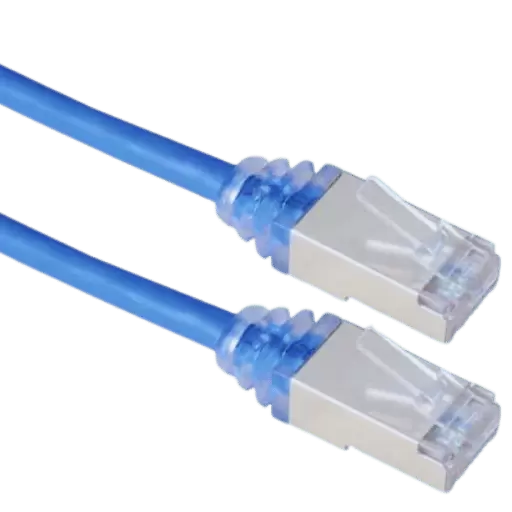
Key Features to Look for in Low-Profile Ethernet Cables
Evaluating certain features is important when selecting a low-profile Ethernet cable and ensuring optimal performance and compatibility with your networking setup. Below is a detailed list of key features that need special attention:
Cable Category (Cat Rating)
- Low profile Ethernet cables come as Cat6, Cat6a, and Cat7, and each one of them offers different speed and bandwidth. For instance, Cat6 supports speeds up to 1 Gbps with a bandwidth of 250 MHz. Similarly, Cat6a and Cat7 offer higher speeds and bandwidth, up to 10 Gbps and 600 MHz or more.
Thickness and Flexibility
- The low profile design of Ethernet cables allows them to fit perfectly in tight spaces as they can be placed on edge or beneath carpets. However, ensure that flexibility is maintained along with durability while selecting the desired cable.
Length Options
- Like all other Ethernet cables, low profile cables are available in various lengths starting from 3 feet to over 100 feet. All users can choose the appropriate cable length for their installation requirements without having excessive slack.
Comparison (STP vs. UTP)
- Shielded Twisted Pair (STP) cables are superior to Unshielded Twisted Pair (UTP) cables when it comes to protection against electromagnetic interference (EMI). In environments with high EMI, such as near electrical equipment, STP cables are advised.
Resilience and Materials
- Look for cabling with ultra-durable PVC outer jackets or those made from LSZH (Low Smoke Zero Halogen) materials, which provide excellent durability. LSZH greatly enhances safety since it emits negligibly toxic smoke when subjected to fire.
Quality of connectors
- Gold-plated connectors should be used. Gold improves conductivity and resists corrosion, degrading over time. Furthermore, molded strain relief also improves the lifespan of the cable at the RJ45 connectors.
Compliance and Evaluation
- These cables must be compliant with TIA/EIA and ISO/IEC certifications and compatible with routers, switches, gaming consoles, and PCs for use with other devices.
Performance metrics
- Attaining the cable’s attenuation, signal-to-noise ratio, and the maximum data rate the cable can support are crucial performing benchmarks. Those metrics guarantee dependable and consistent connectivity, particularly for resource-intensive applications like streaming and online gaming.
By evaluating these features, one is able to make an informed decision and choose an Ethernet cable with a flat profile that fulfills their networking requirements. As always, consider your environment and speed requirements, as well as installation conditions to maximize results.
Comparing Flat Ethernet and Round Cable Options
Contrasting flat Ethernet cables with round cables reveals a significant difference in design, functionality, and performance. Due to its slim, ribbon-like structure, flat Ethernet cables are best suited for installation in narrow spaces like underneath carpets and along baseboards. Their flexibility and low profile assist in keeping setups in homes and offices neat and tidy. Unfortunately, this design may limit shielding options and may exacerbate interference issues in environments with high electromagnetic activity.
With regards to flat cables, round cables have a cylindrical design which enables the bundling of shielding and insulation around the internal wires. This design decreases crosstalk and external interference to provide more stable and dependable signal transmission. These qualities make round cables a better choice for professional or heavy-duty use, such as those found in data centers and other networking setups that require high data rates, low latency, and minimal delays.
From a technical standpoint, the performance differential between flat and round cables could vary depending on the particular cable category, such as Cat5e, Cat6, or Cat7. As an example, the shape does not influence a cable’s data rate or bandwidth; thus, higher-category cables, regardless of their physical form, support faster data rates and larger bandwidth. Moreover, from the standpoint of structure, round cables are better suited for enduring frequent handling or bending because they are more durable over time.
Research shows that while flat cables are easier to install in certain locations, round cables outperform flat ones in more demanding environments, especially those requiring shielding and a high degree of signal fidelity. In conclusion, the selection of Ethernet cables, either round or flat, should be based on one’s unique networking needs, budget constraints, and environmental conditions.
Top 10 Products of Flat Cat6 Ethernet
- Jadaol Cat6 Flat Ethernet Cable – Drives industry changing innovation with its wall-mount featuresand its unparalleled durability, enabling speeds of 10 Gbps.
- Cable Matters Flat Cat6 Ethernet Cable – Strikes a balance between performance and usability in tight spaces with its flexible design, rigid connections, and snagless geometry.
- Ultra Clarity Flat Cat6 Cable – Strives for maximum device compatibility as a standard in the industry, smoothly integrating with consoles and smart devices while retaining superior structural quality.
- Vandesail Ethernet Flat Cat6 Cable – This stands out as lightweight yet heavy in performance, excelling in high-speed data processing capability and reaching 250 MHz.
- CableGeeker Flat Cat6 Ethernet Cable – This cable guarantees reliable data transfer with minimal interference and shielding technology that is designed to protect against outside disruptions.
- Amazon Basics Flat Cat6 Ethernet Patch Cable – Stays true to its name, delivering uncluttered patch cables at low costs while providing dependable connections even for fine tuning networks.
- AT&T Velocity Flat Cat6 Ethernet Cable – Revels in being dual purpose, equally effective in homes and offices as marketed enabling seamless inter-device communication.
- TBMax Flat LAN Cable Cat6 – Stands out with its geometric adaptability needing strong shapes without compromising flexibility for high speed networks.
- iMBAPrice Cat6 Flat Ethernet Cable – Improves precision lower grade copper with its high grade lines, retaining stronger signal integrity with minimal drops and distortion.
- ESTONE Flat Cat6 Network Patch Cable – Stays true to its name predicting demand for patches that stay untangled while delivering untangled sturdy speed performance.
How Do Low Profile Ethernet Cables Impact Internet Speed?
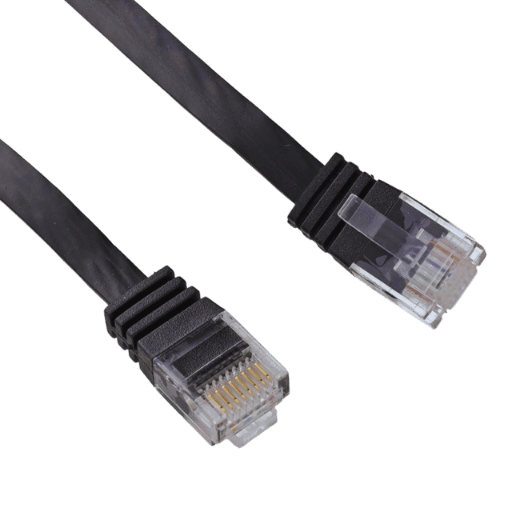
Can a Flat Ethernet Improve Your Connection?
With the appropriate care, flat Ethernet cables can deliver round cable performance when certain quality guidelines are met. These cables are designed to ensure the optimal transmission of data, supporting up to 10 Gbps in compliance with Cat6 or Cat6a standards, which is more than sufficient for contemporary internet needs. It is evident that the most critical factor affecting the connection quality is the construction of the cable itself in terms of grade copper conductors used, shields, and the twisting of pairs of wires, which is intended to reduce EMI.
Balanced cables of this kind, when manufactured correctly, are exceedingly helpful in improving the overall stability of connections in places with high levels of signal interference. For example, Cat6 flat cables have a bandwidth carrying potential of up to 250 MHz, enabling smooth data transitions, which is vital in video streaming or online gaming. Moreover, like other network cables, these cables can also be installed under the carpet or along walls, enabling them to maintain low profiles while preserving the quality of the transmitted signals.
It’s worth repeating that in homes and offices where long cable runs are needed, flat Ethernet cables offer particular benefits. These cables often provide a dependable and easy solution for network setups, as they minimize tangling and simplify installation. Ultimately, the caliber of the cable, alongside its associated network infrastructure, determines the degree of enhancement to be gained regarding connection speed and stability.
Understanding 10gbps and Gigabit Speed Options
When considering options for 10Gbps and Gigabit speeds, the main difference is their data transfer rates. ‘Gigabit Ethernet’ supports speeds up to 1Gbps, which is suitable for most standard applications such as streaming, online gaming, and general data transfers. Contrasting this, 10Gbps Ethernet offers speeds 10 times faster and is often ideal for high-demand scenarios such as large-scale data centers, video editing, or areas with extremely low latency requirements. It is important to note, however, that 10Gbps setups often require higher-grade cables and compatible hardware and incur greater overall costs. For average everyday use, users find that Gigabit Ethernet provides a remarkably efficient solution, while 10Gbps is used for specialized professional or enterprise settings.
Where to Shop for High-Quality Low Profile Ethernet Cables?
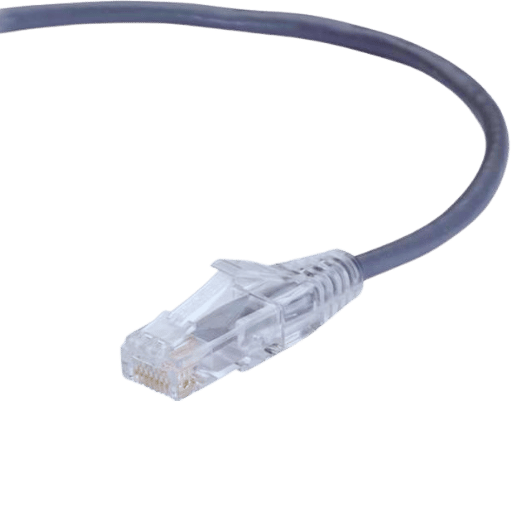
Top Online Stores for Buying Flat Network Cables
Amazon
- Purchasing flat Ethernet cables from reputable companies with different brand options and varying lengths is possible on Amazon. User reviews and ratings help in wading through the options and selecting the best available choice.
Newegg
- A prominent retailer for flat network cables, Newegg offers competitively priced high-quality cables tailored for home or professional use, complete with extensive product descriptions and details.
Best Buy
- Famous for its customer-first policy, Best Buy sells flat Ethernet cables online and at their physical locations, making them a one-stop shop for bedside purchases.
Monoprice
- An industry leader in budget-friendly and high-quality cables, Monoprice offers flat Ethernet cables at economical prices, ensuring superior performance and unparalleled value, alongside trusted quality standards.
Cable Matters (Official Website)
- As a specialized retailer of cables and accessories, this company guarantees a wide assortment of flat Ethernet cables that are both dependable and durable.
What should you consider when designing a brand for Ethernet cables?
When branding Ethernet cables, it is important to examine the technical factors, market, and consumers in order to build credibility and remain competitive in the industry:
Technical Performance
- Ethernet cable brands should market their products based on data transfer speeds, bandwidth, and reliability. For instance, Cat6 and Cat7 cables aid seamless streaming, gaming, and data center operations that require 10 Gbps speed. Moreover, advertising compliance with TIA/EIA and ISO/IEC standards directly increases consumer trust.
Durability and Build Quality
- Ethernet cables should also focus on sustaining performance and protecting sensitive data for consumers. LSZH (Low Smoke Zero Halogen) and PVC sheathing would enable enhanced flexibility, flame resistance and minimal emission in a fire. Also, reinforced cable shielding improves performance by lessening interference that piles on in busy networks.
Design and Usability
- In the residential and commercial sectors, modern, sleek designs coupled with color coding and narrow profile connectors are eye-catching. Flat Ethernet cables are particularly appealing due to their space-saving properties, making routing under carpets or along walls easy without obstructions.
Sustainability and Eco-Friendly Initiatives
- There is a growing consideration of ‘green’ practices by consumers. For instance, using recyclable materials and lesser non-biodegradable packaging can enhance brand image. Moreover, highlighting compliance with certifications like RoHS (Restriction of Hazardous Substances Directive) also adds a brand’s sustainability profile.
Market Demand Trends
- Utilization of smart home appliances and IoT (Internet of Things) technology is associated with an increased need for Ethernet cables that provide high-speed and stable connections. Market compatibility with PoE (Power over Ethernet) – which delivers power and data to a device through a single cable – is an emerging consumer requirement that companies ought to address.
Standout Branding and Marketing Strategies
- A distinctive logo and particular color combination help create a lasting brand identity. Also, branding is an integral part of business strategy, which needs to balance advanced marketing and advertising strategies while focusing on core values of speed, reliability, and durability. Also, some messages can include statistics claiming that brand X reduced data loss by y% while using their Ethernet cables. Such messaging should presented with thorough testing and case studies to enhance credibility. Alongside other benefits, collaboration with recognized certifications will assist in positively marketing and branding a product.
Price and Warranty
- Of equal importance transparency in pricing, competitive pricing and rates is critical. Alongside these, extending warranties or guarantees like lifetime pledges assures trusting support of the product.
Harnessing these Considerations
Through strategy and research, improving technical performance alongside meeting consumer expectations while also considering sustainability will enable brands to lead the market for Ethernet cables. Crafting an optimum balance of specifications alongside marketing will appeal to professionals who seek dependable networking systems and to average users.
Are Flat Ethernet Cables Worth the Money?
As with any networking solution, the decision to invest in flat Ethernet cables depends on your unique requirements. These cables are particularly useful in settings where the saving of space and the management of cables are important, such as running the cable under a carpet or along a wall. Provided that the appropriate category rating is met, flat cables, like round cables, guarantee the same performance in speed and reliability as Cat5e and Cat6. However, round cables are usually more durable, given their thicker insulation which makes them more suited for heavy-duty or outdoor use. Nonetheless, flat Ethernet cables are a pragmatic and cheap alternative that does not compromise the performance of the network for most indoor applications.
How to Use and Install a Low-Profile Ethernet Cable?
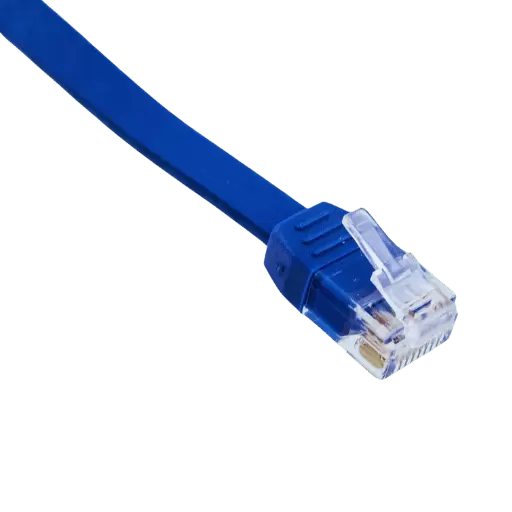
Step-by-Step Guide to Install Flat Ethernet
Draft the Cable Path
- Select the devices that will be connected and draft the path for the flat Ethernet cable. Take the most efficient path, observing that cables will also be affected by bends and interfaces. Since flat cables can be run under carpets, up walls, or behind furniture, they are easier to conceal, leading to better organization.
Measure and Prepare the Cable
- Measure the length of the cable so that it is not too tight or too long, as this can lead to loss of signal. Sufficient length is also necessary so that no strain is used to connect the cable. Select an adjustable cable, such as a flat cable, which comes in various lengths. Also ensure that the cable meets the desired Ethernet standard, such as Cat6 or Cat6a, which allows speeds of up to 10 Gbps while providing additional protection from crosstalk interference.
Secure the Cable
- Using adhesive cable clips or mounting brackets, secure the flat Ethernet wire to walls and ceilings and baseboards. This completes a neat installation without leaving protruding wires that may trip someone. For extended runs or outdoor use, the cables should be safeguarded from physical or weather damage using conduit or tubing.
Connect to Devices
- To connect devices to the network, start by plugging one end of the Ethernet cable into a LAN port located on your router or network switch. Then, connect the other end to the Ethernet port of the device you want to connect, for example, your computer, gaming console, or smart TV. For loose connections, make sure that the plugs are secured fully on both ends.
Test the Connection
- After installation, make sure that your network connection is working. There are several ways to test it: a network diagnostics tool or simply checking your device’s settings, as most modern devices have this built-in and often have a feature to display the state of the network connection along with measuring its speed. Flat Ethernet cables with higher category ratings ought to have their data rates and signal quality meet their specs, as the data rates and signal quality are delivered with higher-level specifications like those provided by the algorithm.
Maintenance and Troubleshooting
- Additional maintenance includes visually examining the installed cable to see if it is showing signs of wear and damage or interference like scratches, regularly for installed cables. If a cable is installed in a crude zone, make sure to replace or repair damaged portions right away. This ensures that your network performance won’t be interrupted. While flat cables are easy to work with, they do need more attention in harsh wear and tear settings.
If done correctly, these steps will enhance the performance and longevity of flat Ethernet cables while providing dependable and effective broadband solutions for your network applications.
Common Issues and Troubleshooting Ethernet Cable Problems
Intermittent Connection Drops
- This might be caused by loose ends or severed sections of the cable. Make sure all connectors are appropriately seated in their ports, and check the cable for damage. Often, this problem is solved by repairing damaged cables.
Slow Network Speed
- Slow connections could be because of the utilization of unsupported bandwidth cables for your network. Ensure the cable you use is of the appropriate category, for example, Cat5e or Cat6 for Gigabit networks.
No connectivity
- In the absence of a connection, test the cable with different devices and ports to isolate the problem. A broken connector or an internal wire would necessitate the replacement of a cable.
Signal Interference
- Electrical devices in close proximity can cause interference, leading to reduced performance. This annoyance could be prevented by moving the Ethernet cables further away from power cords and other possible sources of signal obstruction.
Managing these issues and applying the most basic diagnostic steps will help maintain a stable and efficient connection.
How to Maintain Your Low-Profile Ethernet Setup
Inspect Cables Periodically
- Replace Ethernet cables that have clearly defined cracks or obvious signs of fraying to maintain connectivity.
Verification of Proper Connections
- Check that all connections have been properly inserted into the relevant ports. Loose connections can cause network performance problems.
Minimizing Stress on Cables
- To prevent reduced longevity and damage to internal wiring, do not bend the cables at sharp angles or place heavy objects on them.
Efficient Cable Organization
- Reduce tangling and neatly organize cables using cable ties or clips. Such actions increase accessibility while simultaneously reducing wear.
Avoiding extreme environmental conditions
- Prevent exposing network equipment and cables to direct sunlight, excessive moisture and heat to improve longevity.
Following these recommendations ensures the Ethernet setup is reliable and optimal for prolonged performance.
Frequently Asked Questions (FAQs)
Q: What is a Low Profile Ethernet Cable, and how does it relate to networking?
A: As the name suggests, a Low Profile Ethernet Cable is specifically built as a low network cable to take up less space and be easier to handle in more compact areas. It is best for high-density networking when lots of wiring needs to be done and space is tight, assisting with keeping a neat look and still making sure network connections are effective.
Q: How does the thickness of a Low Profile Ethernet Cable compare to standard cables?
A: Low Profile Ethernet Cables are much thinner than Standard Cables, which makes routing them through tight spaces like server cabinets or behind office desks easy while maintaining low bandwidth. This slim design helps in managing clutter and allows for easier cable management.
Q: Are Low Profile Ethernet Cables available in different lengths, such as 100ft?
A: Of course, Low Profile Ethernet Cables can be found in preset length increments like 100ft, which accommodates different networking needs, so users can purchase them in just about any size they need.
Q: What are the implications of using a Low Profile Ethernet Cable in any network?
A: According to our research and to the network engineers, Low Profile Ethernet Cables can accommodate high-speed transfers as well as bandwidths of up to 250MHZ which is considered the benchmark for homes and business setups which makes them suitable at any point of use.
Q: Does an Ethernet profile impact the ability of Ethernet Low Profile cables to connect to an RJ45 port?
A: Absolutely, Low Profile Ethernet Cables work with standard RJ45 connectors, so users will not have troubles of them fitting on existing networks without changing other parts of the system.
Q: What is the relevance of Low Profile Ethernet Cables towards gaming and office use?
A: In addition to improving the speed and reliability of the network during gameplay or working hours, Low Profile Ethernet Cables also help to manage the clutter that comes with having multiple unmanaged cables, which can result in potential damage.
Q: Is there a specific list of colors for Low Profile Ethernet Cables, including black?
A: Indeed, Low Profile Ethernet Cables come in different colors such as black, which will match your networking environment and personal preference. This enables you to achieve a cohesive look while still taking advantage of the cable’s low profile design.
Q: What steps are necessary to make sure that a Low Profile Ethernet Cable and its packaging is high quality?
A: For high quality, look to reputable manufacturers that provide product details claiming usage of solid copper conductors with compliance to certain industry standards. Evaluation of the customer’s reviews and ratings can also offer useful information about the cable’s quality.
Q: Can Low Profile Ethernet Cables be utilized along with Network Adapters or PCIe cards?
A: Yes, provided that the network adapters or PCIe cards have the matching ports, Low Profile Ethernet Cables can be used with network adapters or PCIe cards. These cables are intended to work with networking equipment so that no integration issues are encountered.
Q: How can Low Profile Ethernet Cables be used within an already existing LAN structure?
A: To incorporate Ethernet Cables of a Low Profile into a LAN configuration, one has first to remove the old equivalence and substitute it with the lower profile version ensuring all the connections are routed to the right ports that include the routers, switches, and computers.
Reference Sources
1. A Low-Profile Dual-Band Dipole Antenna with Hollow Structure Reflector
- Creators: Shun Yao et al.
- Date of Publication: July 14, 2024
- Overview: This paper discusses a low-profile dual-band dipole antenna with Wireless LAN capability. The antenna is built on an FR4 substrate and has a flat reflector that preserves a good direction of radiation pattern and stable directional radiation. Additionally, the stub structure is capable of resonating at various frequency bands. The antenna PCB and reflector PCB are separated by a proximity of 5mm, which is a considerable distance in low-profile designs. The stub antenna has impedance bandwidths of 2.4-2.5 GHz and 5.1-5.89 GHz, exceeding 4 dBi and 6 dBi at lower and upper bands, respectively, and maintains high efficiency and gains(Yao et al., 2024, pp. 635–636).
2. Category 6 cable
3. Patch cable
4. Ethernet
Post Views: 2,319




